New York has Central Park at 843 acres and San Francisco has Golden Gate Park at 1,017 acres of urban public grounds in the city. These are two of the biggest landscaped urban parks in the USA. These urban spaces allow you to lose yourself in the trees and fields and walkways in the middle of a major city.
London Royal Parks
One of the pleasurable aspects of this summer trip to London is the time we have spent walking through the Royal Parks of St. James’s Park (57 acres), Green Park (47 acres), Hyde Park (350 acres), Kensington Gardens (270 acres) and Regent’s Park (410 acres). These five Royal Parks in central London create more public access green space in the city than Central Park or Golden Gate Park.
There are eight Royal Parks in the Greater London region with Richmond Park (2,360 acres) and Bushy Park (1,100 acres) southwest of London being the largest parks, where you will still find large mammals like deer. Greenwich Park in southeast London is 180 acres. London has more green space than any other European city.
The reason for listing the sizes of the Royal Parks is to convey, for the unfamiliar tourist, that central London offers the opportunity to spend many hours in green spaces, away from the hustle and bustle of the busy streets, even when you are in the middle of this city.
Many of the major brand hotels are located near the Royal Parks and we have spent many hours during the hot days this past week hanging out in the Royal Parks of London. We have been within five minutes walk of a park at all three hotels we have stayed in this past week.
Hyde Park gate in southeast corner with Four Seasons London seen in right background and Hilton on Park Lane tower visible behind gate. InterContinental Park Lane is attached to building seen in front of Four Seasons.
Hyde Park was created by Henry VIII in 1536 as a hunting ground. The park was opened to the public in 1637 by King Charles I.
We walked from the InterContinental Park Lane through the south side of Hyde Park and Kensington Gardens one day to visit the Natural History Museum.
The Serpentine is a popular lake in Hyde Park, originally created in the 1730s, and these days the lake is used for boating and even swimming. There are far too many birds in too small a pond for healthy swimming, in my opinion.
Beautiful old large trees line paths in many areas of Hyde Park.
Hyde Park is a contiguous green space with Kensington Gardens where a road runs through the park between the two.
Another morning I decided to walk from The May Fair Hotel (Club Carlson) to Notting Hill and Holland Park to check out these residential areas of London. I walked along the north side of Hyde Park and Kensington Gardens.
The north side of Hyde Park seemed less manicured and a place where you can get away from the city and lost in the trees.
The space in Hyde Park seemed wild enough to sleep out for the night. The Royal Parks are closed at night, but I spotted a person sleeping in the park under trees around 7am in the morning.
Buckhill Lodge in Kensington Gardens is a quaint house that I assumed was occupied by a Royal gardener or warden. Turns out some of these Crown Estates lodges in the Royal Parks are rentals available through the Royal Parks Better Buildings Programme, however, no vacancies at the present time.
Italian Gardens in Kensington Gardens – Imagine this as your early morning view before the tourists arrive.
Peter Pan bronze statue placed in Kensington Gardens May 1, 1912 as a gift from playwright James Barrie, creator of Peter Pan. Sculptor Sir George Frampton. The original Peter Pan play was first performed in London, December 1904.
White swans grooming in The Long Water of Kensington Gardens at morning.
Kensington Palace seen from the far side of the Round Pond. The palace is used as a residence by many members of the Royal family including Prince William and Princess Kate, Duke and Duchess of Gloucester. There is plenty of security on the other side of the palace guarding the access roads.
Princess Diana Memorial Playground is located in the northwest corner of Kensington Gardens and features a large pirate ship. The playground sees over one million visitors a year.
Notting Hill is northwest of Kensington Gardens. Just like in the movie Notting Hill, the parks I walked by in Notting Hill were private gated residential parks.
Holland Park (54 acres) is south of Notting Hill and open to the public during the day. Holland Park is a public park and not part of the Royal parks, but another great green space in the middle of London to get lost. I came to the neighborhood based on my love for the British comedy TV series Absolutely Fabulous, where Edina Monsoon’s house was located.
Green Park is the Royal Park southeast of Hyde Park and across Piccadilly Road from The May Fair Hotel and Intercontinental Park Lane, two of the hotels where we stayed this week. Green Park leads to Buckingham Palace.
Green Park borders the private walled gardens of Buckingham Palace, separated by Constitution Hill road. Queens Walk was created in 1730 for Queen Caroline, wife of George II, who enjoyed walking through the park.
Regent’s Park
North London has Regent’s Park and Primrose Hill. We walked through Regent’s Park when we stayed at the Holiday Inn Camden Lock. Regent’s Park has the London Zoo, Regent’s College, Regent’s Canal and boating lakes.
Architect John Nash designed Regent’s Park in 1811 and most of the park was opened to the public in 1841. The London Zoo, opened in 1828 in the northeast corner of the park, is a 15 minute walk from Camden Town.
John Nash also designed Buckingham Palace.
Gate to Queen Mary’s Gardens in Regent’s Park
A pair of back swans were feeding in Queen Mary’s Gardens. Extensive rose bushes of many colors were in full bloom. The birds were the highlight of Regent’s Park for me with sightings of black swans, a pair of white swans with three cygnets and more great blue herons than I have ever seen in one place. The most amazing aspect of these birds is their approachability. They seemed totally accustomed to humans and it was possible to get very close to birds without scaring them into flight.
Great blue herons in Regent’s Park. I probably saw 20 of these.
Even more adorable were a pair of white swans and their three cygnets. These swans paid no attention to a toddler standing at the side of the pond five feet away.
This is an image showing the London Central Mosque minaret seen from Regent’s Park. The British Empire in the early 20th century had more Muslims than Christians, yet there was no mosque in London. The British Government in WWII gifted 2.3 acres of land adjacent to Hanover Gate in Regent’s Park to the UK Muslim community for a mosque. The mosque was finally completed in 1977. An interesting side-note is the mosque and Islamic Cultural Center is just outside Regent’s Park and across the street from the U.S. Ambassador’s residence at Winfield House on 12 acres of grounds within Regent’s Park.
Too many men with machine guns standing outside Winfield House to snap anything, but a quick photo of the sign.
One of the unexpected sights in Regent’s Park was The Trapeze School.
Regent’s Canal borders Regent’s Park and is a popular tourist canal boat waterway between Paddington and Camden in north London.
This peacock at the London Zoo was a bit more stable gripping onto a bar in the air than the trapeze school student.
London can be a crowded and overwhelming urban environment. The Royal Parks are places to de-stress and enjoy the city at a more leisurely pace.


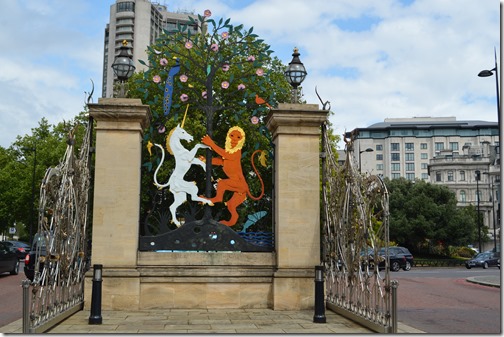
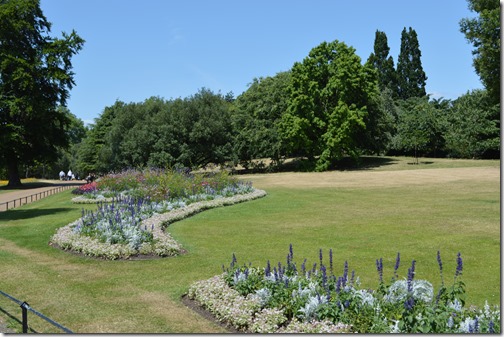
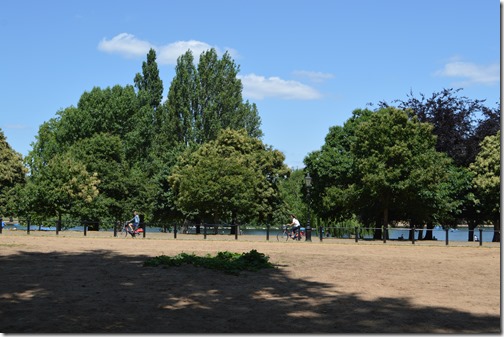
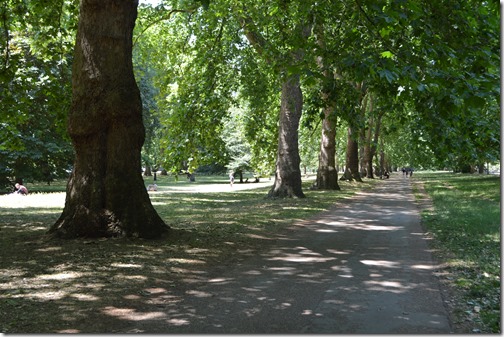
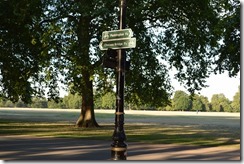
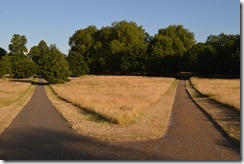
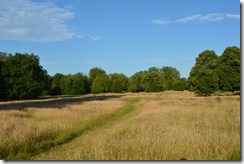
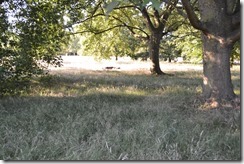
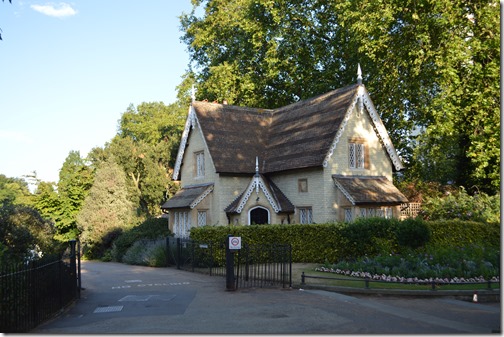
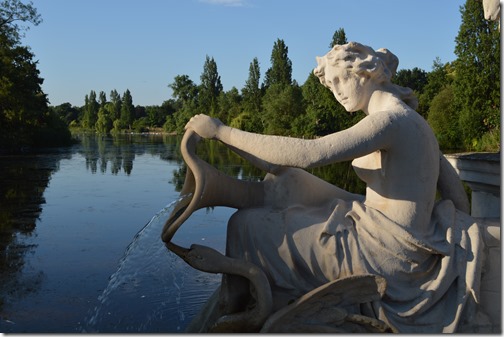
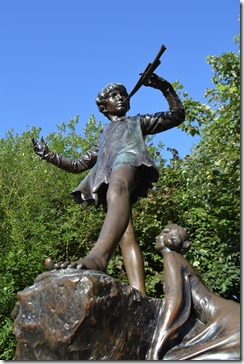
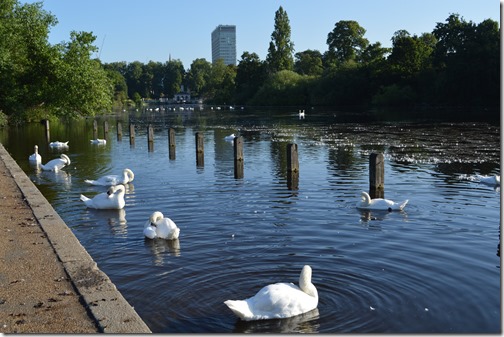
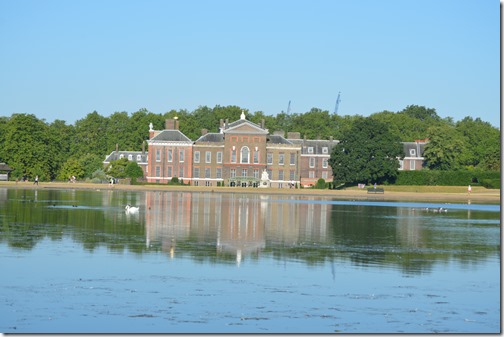
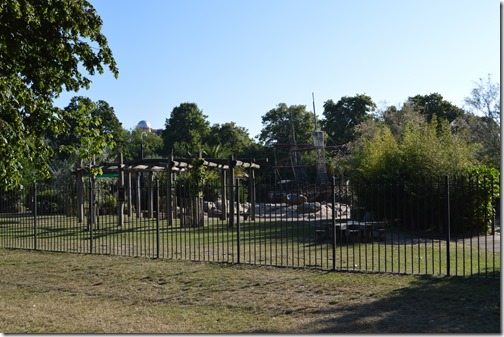
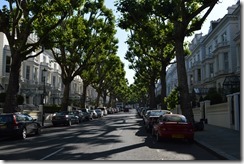
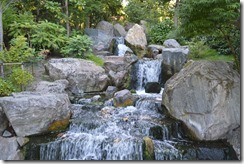
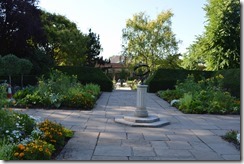
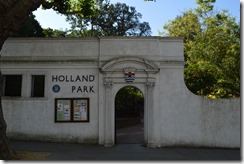
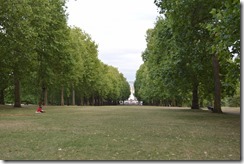
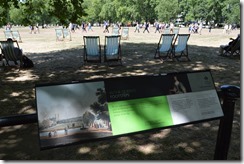
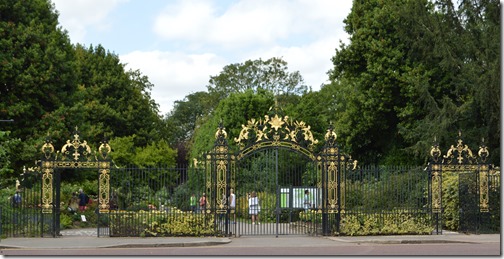
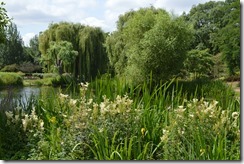
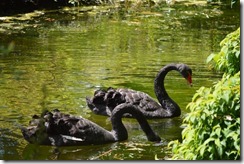
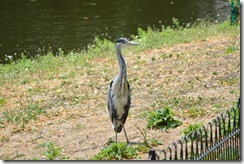

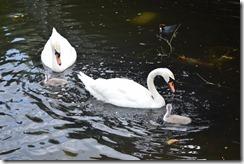


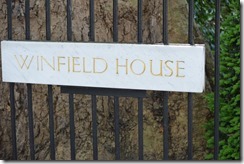
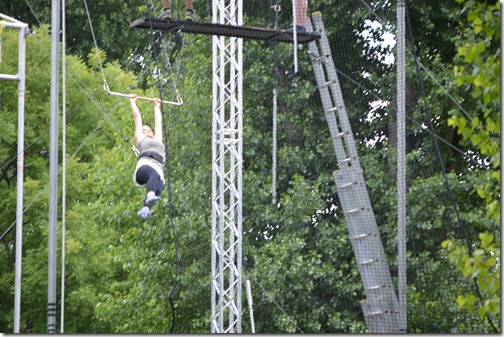
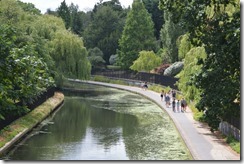

1 Comment
Comments are closed.